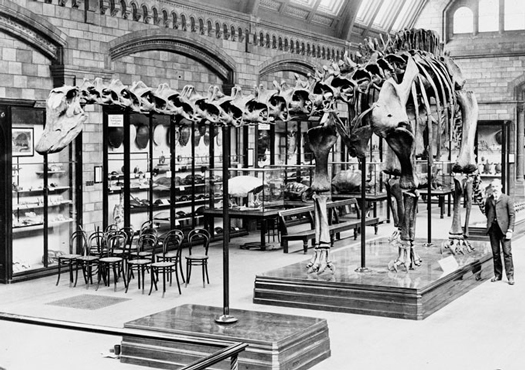Farewell to “Dippy the Diplodocus”
Today, Wednesday 4th January, is the last day that the Diplodocus replica, affectionately named “Dippy” will be on display at the Natural History Museum, London. The twenty-one-metre-long plus plaster cast fossil exhibit will be dismantled starting tomorrow. This is part of preparations to turn this iconic dinosaur skeleton into a touring exhibit for the museum.
The Last Day for “Dippy” on Display at the Hintze Hall (London Natural History Museum)
Picture credit: Press Association/Matt Dunham
Diplodocus Skeleton
The Diplodocus skeleton has graced the Hintze Hall since 1979, but the museum authorities have decided that “Dippy” must make way for another skeleton, a massive female Blue Whale (Balaenoptera musculus).
The Blue Whale has been housed at the museum since 1891, the whale skeleton, actual bone, has been part of the vertebrate collection for longer than the Diplodocus replica. The unfortunate whale was injured by a whaler and subsequently beached at the mouth of Wexford Harbour (Ireland), it was acquired by the museum and it has been on display in the Hall of Mammals, but it will soon be taking centre stage and welcoming visitors at the Cromwell Road entrance.
An Artist’s Impression of How the New Blue Whale Exhibit Will Look
Picture credit: Casson Mann
Not the First Whale Exhibit to Grace the Hintze Hall
The Blue Whale, the largest exhibit of its kind (as far as Everything Dinosaur team members are aware), is not the first huge whale to grace the Hintze Hall. In the late 1890s a Sperm Whale skeleton (Physeter macrocephalus) was located in a central position in the spacious gallery.
A Generous Gift from Andrew Carnegie
“Dippy’s” story began in 1898, when construction workers building a railway in Wyoming, discovered the spectacular fossilised bones of a Diplodocus. Scottish-born millionaire and philanthropist, Andrew Carnegie, got to hear about it and he acquired the 150-million-year-old fossil bones with a view to making the Diplodocus the centrepiece for the Carnegie Museum of Natural History (Pittsburgh, Pennsylvania).
During fossil preparation and reconstruction of the mounted skeleton, American palaeontologists noted a number of anatomical differences between the Carnegie specimen and the original holotype Diplodocus material that had led to the erection of the genus back in 1878. This meant that the Wyoming Diplodocus acquired by Mr Carnegie was a new species, the specific epithet Diplodocus carnegii was established, the trivial name honouring the Scottish-born industrialist.
Diplodocus carnegii
King Edward VII viewed a sketch of the Diplodocus skeleton whilst visiting Andrew Carnegie in Scotland. The King remarked how he would very much like to see a similar exhibit at the British Museum (the formal name for the Natural History Museum, London). Carnegie wanted to indulge the King and he commissioned a plaster cast replica, one of ten replicas of the original fossil material that were eventually created. The Diplodocus replica was sent to London in January 1905 and it was formally unveiled at the museum on May 12th that year.
The Diplodocus Exhibit circa 1905
Picture credit: Press Association
Visit the Everything Dinosaur website: Everything Dinosaur.
An Evolving Diplodocus Skeleton
For many decades, the 292 individual bones that make up the Diplodocus skeleton were kept in the same anatomical position. Although, our understanding of sauropod anatomy has increased enormously since “Dippy” was first mounted. Two major revisions have occurred over the last fifty years or so. Firstly, the head has been raised and the snout of the dinosaur points forward. In the picture below, the head is dipped and the snout is pointing towards the floor at around a forty-five-degree angle. Ironically, in the 1905 photograph above, the head is in a position more akin to the modern interpretation of the head posture of a diplodocid.
“Dippy” on Display in a Museum Gallery
Picture credit: Trustees of the Natural History Museum
In 1993, a second major revision took place. The tail of the dinosaur was raised off the ground and given a more “whip-like” appearance to demonstrate a greater range of movement. Research, in conjunction with a lack of tail drag marks in sauropod fossil tracks, had shown that these dinosaurs walked with their tails held out behind them. The tail raised off the ground helped to counterbalance the head and neck.
“Son of Dippy”
It is a sad day for many fans of dinosaurs, to see the removal of “Dippy” from the Cromwell Road entrance to the museum. However, once cleaned “Dippy” is embarking on a nationwide tour in early 2018 and plans have been announced to exhibit a bronze replica of the iconic dinosaur in a newly landscaped area outside the museum. This replica, which will be created using the original display, has already been nick-named “Son of Dippy”.
Future visitors to the London Natural History Museum will be able to get their “Diplodocus fix”, but for the moment, we bid farewell to the Diplodocus replica, an exhibit that has been seen by an estimated 90 million visitors and one that has inspired generations of palaeontologists.
For Natural History Museum dinosaur models and figures: Natural History Museum Dinosaur Models.










I remember going to the museum before Dippy was on display in the main hall. Personally it doesn’t bother me what they have on display in the main hall. What does bother me is the lack of funding of museums in the UK and the many closures that are taking place. The whole Dippy controversy is nothing but a distraction from the real issues facing our museums.
@Senua: Yeah, I think you’re right, in a way; it’s just that I dont’ get to travel much, and would have liked to have seen Dippy again before it was dismantled…